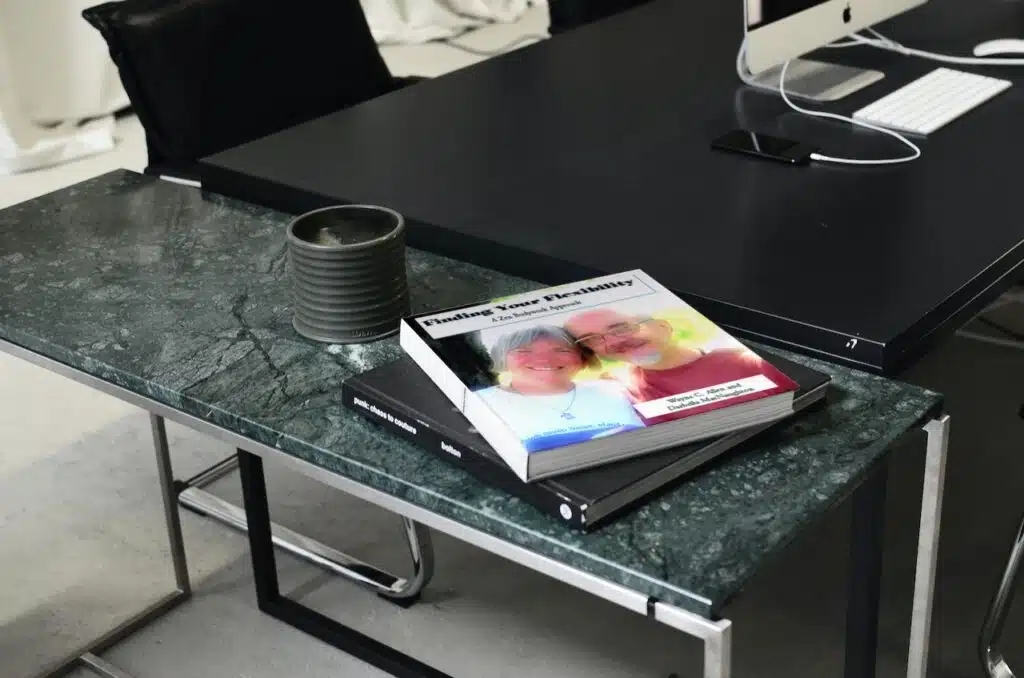My wife Darbella and I were asked to lead a 3‑hour Meditation Practice seminar on alternatives to drugs for pain management, this for Ontario’s Workplace Safety & Insurance Board (WSIB.) At the end of the seminar, we offered to run an all day workshop.
We ended up creating online videos and book, featuring the best of what we teach around here—self-responsible living and being.
Throughout Finding Your Flexibility, we contrasted Eastern and Western approaches to living, to Bodywork and exercise, and to life flexibility.
We recently re-structured the entire project, making it perfect for anyone who wants to create a new way of being, while gaining physical flexibility.
This downloadable e‑book, combined with online videos, is truly life-changing.
- I included all the Eastern philosophies and techniques I’d learned. I realized that there was a direct and fundamental connection between what people thought (clung to) and what was happening in their bodies.
- I added in a Western version of Bodywork. Bodywork theory states that our bodies hold within their physical structure the story of our unresolved issues and past traumas, physical and psychological. A trained Bodywork practitioner can simply look at how you carry yourself and can thereby tell you much of your life story.
So, let’s apply this to you. You might ask yourself:
“What, specifically, might I do differently, to create more spaciousness in my life and flexibility in my body?”
Eastern methods assume that the body is filled with energy. This energy can be directed, and used for healing. You’ll hear us talk a bit about meridians, about energy (called chi or Qi,) and about how energy blockages cause the body to be “out of balance.”
In Eastern thought, our bodies are seen holistically, as BodyMindSpirit. We are designed to naturally be in balance. Internal illnesses and external injuries cause the energy to flow un-naturally, and this in turn leads to pain and inflexibility.
One goal of this program is greater energy flow—we assume that this will happen as the body comes more and more into balance.
In other words, through specific exercises and Meditation Practice, we’ll treat the imbalance, and allow “balance” to take care of itself.
We mentioned that there are things you’d need to “get,” and here’s the first one.
- You will need to accept the idea that your body is holding unexpressed emotions and traumas. These unexpressed items almost always start small, are unnoticed and ‘stuffed,’ and grow larger, until we can ignore them no more.
- We call this understanding “the core of self-responsibility.”
In other words,
“I am how I am, right now, because of how I thought, acted, and dealt with my life, up to now.”
Finding Your Flexibility will help you to “meet” yourself, to identify areas you have been ignoring, and to gently turn your attention to those things. No one but you can turn the tide. You’ll have to break habits and learn to think and act in a new way, but hey, the way you were doing things hasn’t exactly panned out, now has it?
The real work is always self-work.
Pain and Suffering
Pain is one reality that touches all of our lives. For all of us, there will be the emotional pain of grief and loss. If we are injured, there must be physical pain. In every life, pain is not optional.
Suffering, however, is optional.
All suffering is self-imposed. The Buddha’s first truth is, “Life is suffering.” But his second truth is, “All suffering is caused by clinging and aversion.”
- One root of suffering comes from clinging to the past—wanting everything to be the way it was before the ‘bad things’ happened. This, of course, will not and cannot ever happen, no matter how much you wish it were so. And so, you suffer.
- The other root of suffering comes from dreading the future—and making that future as grim as possible. I won’t get into why we do this—it’s not worth the reading. This imaginary story causes us to physically tighten up, and to dump a load of adrenaline into our systems—and this, in turn, adds to our inflexibility and misery.
Most choose hardening and tightening around their misery, while adding in the “This isn’t fair” litany. And so, they suffer.
So, what is the alternative?
The Buddha’s third truth: If you let go of clinging and aversion, and live your life fully and completely, you can let go of suffering (but not pain, sickness, and death—this is not optional!)
In other words, situations do not change—you do!
I am not minimizing your pain—I am simply saying that it is ‘how it is.’ There will always be physical pain, and there will always be situations that are agonizing. There will always be depraved people preying on innocents, and tragedy and death are as much a part of life a blue skies and sunsets. Bemoaning the existence of such painful situations changes precisely nothing.
Creating another way of being with the situation is always possible. The key to living life with a minimum of suffering is to hold life, and your opinions, loosely. While it is tempting to play the “It’s not fair” game, it is essential to remember that this accomplishes nothing in the real world.
Our Finding Your Flexibility Program is a Great Alternative! You’ll find Peace, Presence, Contentment — and Will Learn to Drop the Stories That are no Longer Working
Building upon the insights contained in my popular book, This Endless Moment, this downloadable book and online video combination provides an excellent opportunity to find peace, presence, contentment, by developing a grounded, centered meditation practice.
You’ll learn flexible body movement, (Qi Gong, Supported Yoga, and walking meditation), Body and Breathwork techniques, and Zen-based Mindfulness approaches to living life fully and deeply.
You will discover a powerful Zen Meditation Practice and Mindfulness relaxation techniques, geared toward finding inner peace and tranquility.
- You will explore traditional Eastern approaches to the movement of Qi Energy.
- You will learn two yoga sets designed to increase your flexibility and level of relaxation.
- You will discover how to breathe efficiently and deeply.
- You will discover how to see your body’s holding patterns, to learn to adjust your body posture, so as to reset yourself to “neutral.”
- You will learn Qi Gong techniques that will allow you to develop and strengthen your Qi, as a healing, calming, and meditative force.
- You will learn to look at your life differently.
- You’ll learn to be self-responsible—to take an active part in how you view and live your life.
You will find a new sense of freedom, as you accept yourself, as you are—where you are.

